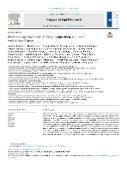Plant and algal lipidomes: Analysis, composition, and their societal significance

Author
Jouhet, Juliette
Alves, Eliana
Boutte, Yohann
Darnet, Sylvain
Domergue, Frederic
Durand, Thierry
Fischer, Pauline
Fouillen, Laetitia
Grube, Mara
Joubes, Jerome
Kalnenieks, Uldis
Kargul, Joanna M.
Khozin-Goldberg, Inna
Leblanc, Catherine
Letsiou, Sophia
Lupette, Josselin
Markov, Gabriel
Medina, Isabel
Melo, Tania
Momchilova, Svetlana
Mongrand, Sebastien
Moreira, Ana S. P.
Neves, Bruna B.
Ogere, Camille
Rey, Felisa
Santaeufemia, Sergio
Schaller, Hubert
Schleyer, Guy
Tietel, Zipora
Zammit, Gabrielle
Ziv, Carmit
Domingues, Rosario
Publication date
2024Published in
Progress in Lipid ResearchVolume / Issue
96 (November 2024)ISBN / ISSN
ISSN: 0163-7827ISBN / ISSN
eISSN: 1873-2194Metadata
Show full item recordCollections
This publication has a published version with DOI 10.1016/j.plipres.2024.101290
Abstract
Plants and algae play a crucial role in the earth's ecosystems. Through photosynthesis they convert light energy into chemical energy, capture CO2 and produce oxygen and energy-rich organic compounds. Photosynthetic organisms are primary producers and synthesize the essential omega 3 and omega 6 fatty acids. They have also unique and highly diverse complex lipids, such as glycolipids, phospholipids, triglycerides, sphingolipids and phytosterols, with nutritional and health benefits. Plant and algal lipids are useful in food, feed, nutraceutical, cosmeceutical and pharmaceutical industries but also for green chemistry and bioenergy. The analysis of plant and algal lipidomes represents a significant challenge due to the intricate and diverse nature of their composition, as well as their plasticity under changing environmental conditions. Optimization of analytical tools is crucial for an in-depth exploration of the lipidome of plants and algae. This review highlights how lipidomics analytical tools can be used to establish a complete mapping of plant and algal lipidomes. Acquiring this knowledge will pave the way for the use of plants and algae as sources of tailored lipids for both industrial and environmental applications. This aligns with the main challenges for society, upholding the natural resources of our planet and respecting their limits.
Keywords
Lipids, Fatty acids, Lipidomics, Plants, Macroalgae, Microalgae, Seaweeds
Permanent link
https://hdl.handle.net/20.500.14178/2926License
Full text of this result is licensed under: Creative Commons Uveďte původ-Neužívejte dílo komerčně-Nezpracovávejte 4.0 International







